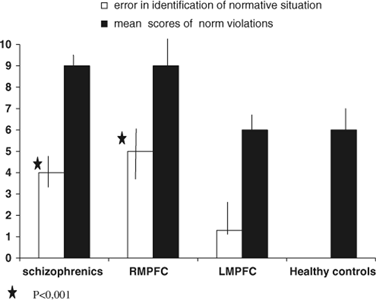Deficit of social cognition in subjects with surgically treated frontal lobe lesions and in subjects affected by schizophrenia
- PMID: 17036260
- PMCID: PMC1800370
- DOI: 10.1007/s00406-006-0676-0
Deficit of social cognition in subjects with surgically treated frontal lobe lesions and in subjects affected by schizophrenia
Abstract
The ability of humans to predict and explain other people's behaviour by attributing independent mental states such as desires and beliefs to them, is considered to be due to our ability to construct a "Theory of Mind". Recently, several neuroimaging studies have implicated the medial frontal lobes as playing a critical role in a dedicated "mentalizing" or "Theory of Mind" network in the human brain. In this study we compare the performance of patients with right and left medial prefrontal lobe lesions in theory of mind and in social cognition tasks, with the performance of people with schizophrenia. We report a similar social cognitive profile between patients with prefrontal lobe lesions and schizophrenic subjects in terms of understanding of false beliefs, in understanding social situations and in using tactical strategies. These findings are relevant for the functional anatomy of "Theory of Mind".
Figures





Similar articles
-
The impact of extensive medial frontal lobe damage on 'Theory of Mind' and cognition.Brain. 2004 Apr;127(Pt 4):914-28. doi: 10.1093/brain/awh108. Epub 2004 Mar 3. Brain. 2004. PMID: 14998913
-
Social cognition in schizophrenia: similarities and differences of emotional perception from patients with focal frontal lesions.Eur Arch Psychiatry Clin Neurosci. 2009 Jun;259(4):227-33. doi: 10.1007/s00406-008-0860-5. Epub 2009 Feb 17. Eur Arch Psychiatry Clin Neurosci. 2009. PMID: 19224113
-
Social cognition and frontal lobe pathology in schizophrenia: a voxel-based morphometric study.Neuroimage. 2007 Mar;35(1):292-8. doi: 10.1016/j.neuroimage.2006.10.046. Epub 2007 Jan 19. Neuroimage. 2007. PMID: 17240165
-
[Hypofrontality and negative symptoms in schizophrenia: synthesis of anatomic and neuropsychological knowledge and ecological perspectives].Encephale. 2001 Sep-Oct;27(5):405-15. Encephale. 2001. PMID: 11760690 Review. French.
-
[Cognition, schizophrenia and the effect of antipsychotics].Encephale. 2006 May-Jun;32(3 Pt 1):341-50. doi: 10.1016/s0013-7006(06)76162-0. Encephale. 2006. PMID: 16840928 Review. French.
Cited by
-
Kinematic analysis of facial behaviour in patients with schizophrenia under emotional stimulation by films with "Mr. Bean".Eur Arch Psychiatry Clin Neurosci. 2008 Apr;258(3):186-91. doi: 10.1007/s00406-007-0778-3. Eur Arch Psychiatry Clin Neurosci. 2008. PMID: 18071625
-
Symptom domains and neurocognitive functioning can help differentiate social cognitive processes in schizophrenia: a meta-analysis.Schizophr Bull. 2013 Jan;39(1):102-11. doi: 10.1093/schbul/sbr067. Epub 2011 Jul 15. Schizophr Bull. 2013. PMID: 21765165 Free PMC article.
-
Contextual social cognition impairments in schizophrenia and bipolar disorder.PLoS One. 2013;8(3):e57664. doi: 10.1371/journal.pone.0057664. Epub 2013 Mar 8. PLoS One. 2013. PMID: 23520477 Free PMC article. Clinical Trial.
-
Intention, false beliefs, and delusional jealousy: insights into the right hemisphere from neurological patients and neuroimaging studies.Med Sci Monit. 2011 Jan;17(1):RA1-11. doi: 10.12659/msm.881314. Med Sci Monit. 2011. PMID: 21169919 Free PMC article. Review.
-
The Use of "Literary Fiction" to Promote Mentalizing Ability.PLoS One. 2016 Aug 4;11(8):e0160254. doi: 10.1371/journal.pone.0160254. eCollection 2016. PLoS One. 2016. PMID: 27490164 Free PMC article.
References
-
- {'text': '', 'ref_index': 1, 'ids': [{'type': 'DOI', 'value': '10.1037/0033-2909.121.1.114', 'is_inner': False, 'url': 'https://doi.org/10.1037/0033-2909.121.1.114'}, {'type': 'PubMed', 'value': '9000894', 'is_inner': True, 'url': 'https://pubmed.ncbi.nlm.nih.gov/9000894/'}]}
- Penn DL, Corrigan PW, Bentall RP, Racenstein JM, Newman L (1997) Social cognition in schizophrenia. Psychol Bull 121:114–132 - PubMed
-
- {'text': '', 'ref_index': 1, 'ids': [{'type': 'DOI', 'value': '10.1037/h0049307', 'is_inner': False, 'url': 'https://doi.org/10.1037/h0049307'}, {'type': 'PubMed', 'value': '13684985', 'is_inner': True, 'url': 'https://pubmed.ncbi.nlm.nih.gov/13684985/'}]}
- Atkinson RL, Robinson NM (1961) Paired-associate learning by schizophrenic and normal subjects under conditions of personal and impersonal reward and punishment. J Abnorm Soc Psychol 62:322–326 - PubMed
-
- {'text': '', 'ref_index': 1, 'ids': [{'type': 'PubMed', 'value': '3167363', 'is_inner': True, 'url': 'https://pubmed.ncbi.nlm.nih.gov/3167363/'}]}
- Cutting J, Murphy D (1988) Schizophrenic thought disorders. A psychological and organic interpretation. Br J Psychiatry 152:310–319 - PubMed
-
- {'text': '', 'ref_index': 1, 'ids': [{'type': 'PubMed', 'value': '509004', 'is_inner': True, 'url': 'https://pubmed.ncbi.nlm.nih.gov/509004/'}]}
- Frith CD (1979) Consciousness, information processing and schizophrenia. Br J Psychiatry 134:225–235 - PubMed
-
- {'text': '', 'ref_index': 1, 'ids': [{'type': 'PubMed', 'value': '8733211', 'is_inner': True, 'url': 'https://pubmed.ncbi.nlm.nih.gov/8733211/'}]}
- Frith CD, Corcoran R (1996) Exploring “theory of mind” in people with schizophrenia. Psychol Med 26:521–530 - PubMed
Publication types
MeSH terms
LinkOut - more resources
Full Text Sources
Medical

